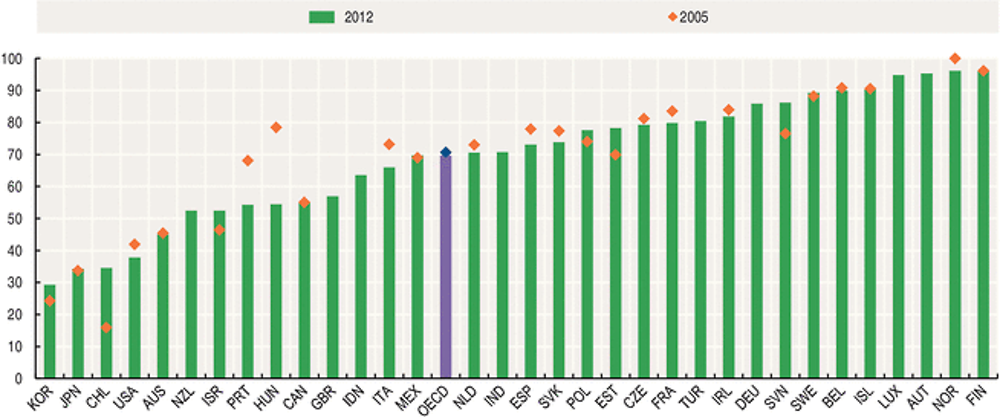Expenditure in tertiary education
Educational institutions in OECD countries are mainly publicly funded, although there are substantial and growing levels of private funding at the tertiary level. At this level, the contribution to the costs of education by individuals and other private entities is more and more considered an effective way to ensure funding is available to students regardless of their economic backgrounds.
Definition
Covered are public and private expenditure on schools, universities and other private institutions delivering or supporting educational services. Other private entities include private businesses and non-profit organisations, e.g. religious organisations, charitable organisations and business and labour associations. Expenditure by private companies on the work-based element of school- and work-based training of apprentices and students is also taken into account.
Private expenditure is recorded net of public subsidies to educational institutions; it also includes expenditures made outside educational institutions.
Comparability
The data on expenditure were obtained by a survey conducted in 2011 which applied consistent methods and definitions. Expenditure data are based on the definitions and coverage for the UNESCO-OECD-Eurostat data collection programme on education; they have been adjusted to 2012 prices using the GDP price deflator. The use of a common survey and definitions ensures good comparability of results across countries.
Educational expenditure in national currency for 2012 is converted into equivalent USD by dividing the national currency figure by the purchasing power parity (PPP) index for GDP. PPPs are used because market exchange rates are affected by many factors that are unrelated to the purchasing power of currencies in different countries.
In 2012, the average level of expenditure per tertiary student, across OECD countries, was USD 15 028. Spending per student at tertiary level ranged from USD 8 000 or less in Chile, Indonesia, Latvia, South Africa and Turkey to more than USD 20 000 in Canada, Norway, Sweden, Switzerland, the United Kingdom, and the United States and even more than USD 30 000 in Luxembourg.
Expenditure on tertiary education amounts to more than 1.5% of GDP in more than half of all countries, and exceeds 2.0% in Canada (2.5%), Chile (2.5%), Korea (2.3%) and the United States (2.8%). Five countries devote less than 1% of GDP to tertiary education, namely Brazil (0.9%), Italy (0.9%), Indonesia (0.8%), Luxembourg (0.4%) and South Africa (0.7%).
High private returns to tertiary education suggest that a greater contribution to the costs of education by individuals and other private entities may be justified, as long as there are ways to ensure that funding is available to students regardless of their economic backgrounds.
The proportion of expenditure on tertiary institutions covered by individuals, businesses and other private sources, including subsidised private payments, ranges from 5% or less in Finland and Norway (tuition fees charged by tertiary institutions are low or negligible in these countries), to more than 40% in Australia, Canada, Chile, Hungary, Israel, Japan Korea, New Zealand, the United Kingdom and the United States, and to over 70% in Korea. Of these countries, in Korea and the United Kingdom, most students are enrolled in private institutions (around 80% in private universities in Korea; 100% in government-dependent private institutions in the United Kingdom).
Sources
-
OECD (2015), Education at a Glance, OECD Publishing.
Further information
Analytical publications
-
OECD (2016), Trends Shaping Education, OECD Publishing.
-
OECD (2015), Reviews of National Policies for Education, OECD Publishing.
-
OECD (2014), Higher Education Management and Policy, OECD Publishing.
Methodological publications
-
OECD/Eurostat/UNESCO Institute for Statistics (2015), ISCED 2011 Operational Manual: Guidelines for Classifying National Education Programmes and Related Qualifications, OECD Publishing.
Online databases
Websites
-
OECD Education at a Glance (supplementary material), www.oecd.org/education/education-at-a-glance-19991487.htm.

